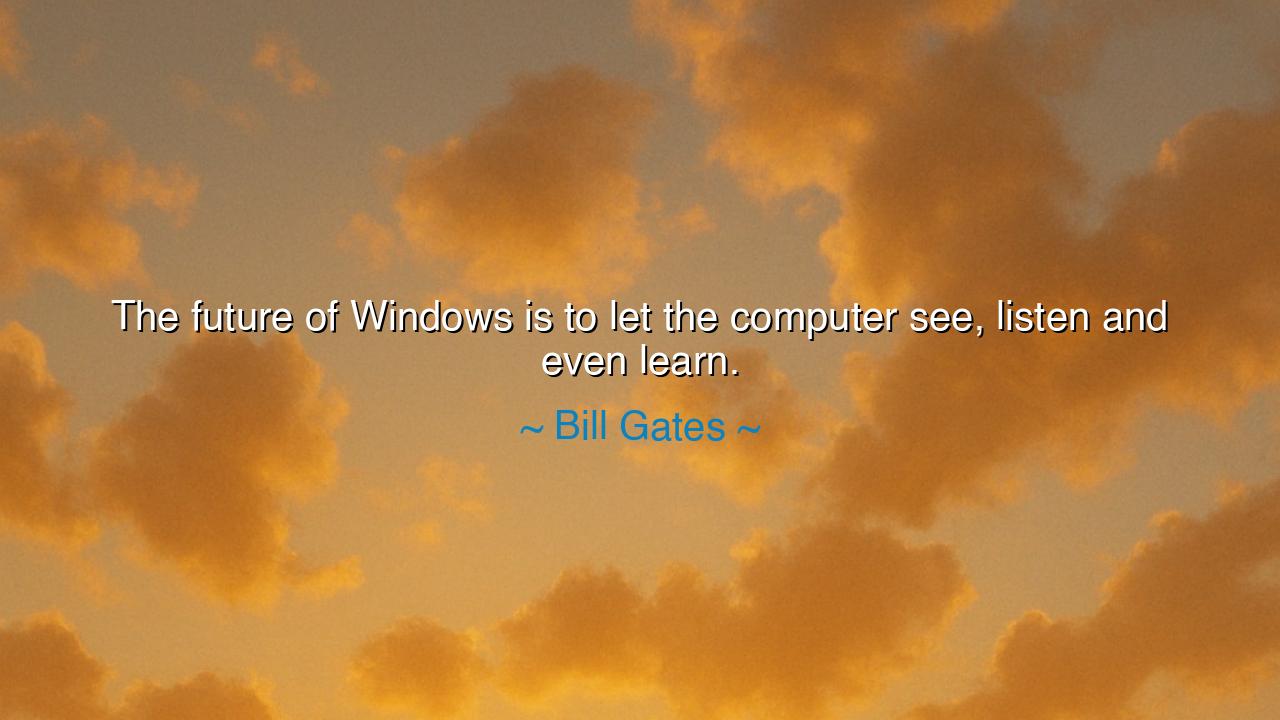
The future of Windows is to let the computer see, listen and even






In the visionary words of Bill Gates, we are beckoned toward a future where technology no longer merely serves as a tool, but becomes an active participant in the world around us. The future of Windows, as he imagines it, is not confined to a machine that simply processes commands but to one that can see, listen, and learn—a future where computers engage with the world not as passive objects, but as intelligent, perceptive entities. This vision speaks to the deep human desire to create machines that can interact with us, not just through input and output, but in a way that mirrors human perception and learning. It is a vision that holds within it the promise of a new relationship between humanity and technology, one where the boundaries between the two blur, where the future is no longer shaped by what we know today but by what technology will teach us tomorrow.
This concept of learning machines is not new. In the ancient world, mechanical devices were seen as tools, extensions of the human hand and mind, but the idea of a thinking machine, one that could learn and adapt, was the subject of many myths and dreams. Consider the tale of Hephaestus, the Greek god of blacksmiths, who created automata, mechanical beings that could move and act on their own, an early vision of a thinking machine. Though these creations were far from intelligent, they embodied the dream of craftsmanship and automation, the desire to create tools that could mimic the powers of human thought and perception. In a way, Bill Gates’s words are a modern continuation of that ancient dream: to build not just machines that serve us, but machines that understand us, that learn from us.
Just as the Greeks imagined machines with life, so too did the Renaissance thinkers and scientists, such as Leonardo da Vinci, who sought to create flying machines and robotic assistants that would one day mirror the functioning of human beings. These were visions of the future, bound not by the limitations of their time but by a deep belief in the potential of human ingenuity. Like Gates, they were driven by the hope that technology could transcend its role as a mere tool and become a force capable of engaging with the world in profound ways. This is the essence of Gates's statement—the future of technology lies not in its ability to perform tasks, but in its ability to understand, adapt, and learn in a way that mirrors the human experience.
Take, for instance, the story of Alan Turing, the visionary mathematician who laid the groundwork for modern computing and artificial intelligence. Turing’s creation of the Turing Machine was not just about building a device to calculate numbers, but about imagining a machine that could think. Turing famously asked, “Can machines think?” This question laid the foundation for the entire field of artificial intelligence, one that seeks not only to program computers to perform tasks but to teach them to learn, to adapt, and to make decisions. Turing’s legacy, like Gates's vision, is one of pushing the boundaries of what we consider possible, showing us that the future of computing lies not in its mechanical perfection, but in its ability to evolve and engage with the world.
The lesson here is profound: to build technology that can see, listen, and learn is not merely to create a better machine—it is to build a tool that can transform the very way we interact with the world. We are at the threshold of a new era, one where our relationship with machines evolves from simple interaction to collaboration. Much like the ancient philosophers who dreamed of understanding the nature of life and existence, today’s visionaries are dreaming of a world where machines do more than function; they understand, they learn, and they grow alongside us.
As we move forward into this future, we must ask ourselves: how do we prepare for a world where technology is no longer just a tool, but a partner in learning and discovery? The first step is to embrace the unknown, to trust in our ability to shape and guide the technologies we create. Just as the ancient dreamers pushed the boundaries of their own time, so too must we push the boundaries of what is possible. We must not be afraid of the changes that will come with this new age but instead, approach them with curiosity and courage.
In our own lives, we must learn to view technology not as something separate from us but as a part of our shared journey. The tools we create can shape the world, but they will be most powerful when we allow them to evolve with us. As we build and interact with these learning machines, let us do so with a sense of responsibility, guiding them toward goals that enrich our world rather than isolate us from it. The future of technology, like the future of humanity, will be shaped by the choices we make today, and the greatest gift we can give future generations is a world where technology and humanity are not separate, but intertwined in a shared journey toward greater understanding and possibility.






AAdministratorAdministrator
Welcome, honored guests. Please leave a comment, we will respond soon